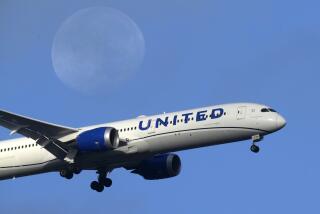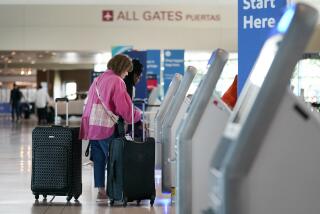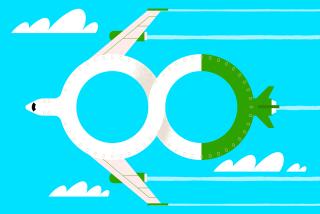Getting the goods
NOW that too many miles are chasing too few awards, how can you get those free tickets and upgrades? You must earn -- and spend -- your miles wisely.
Here’s what has worked for me, allowing me to make numerous free trips and give tickets and upgrades to family and friends.
*
EARN WISELY
Loyalty is essential. Identify one airline whose route system most closely matches your usual travel areas and where you would like to take your free trips. Fly that airline as often as possible so you accumulate most of your miles in one account.
Remember international alliances. Many U.S. carriers have joined international frequent-flier alliances. Star Alliance, for example, has 17 members, including United, Lufthansa and Singapore airlines. OneWorld’s eight members include American, British Airways and Qantas.
Through these alliances, you can usually accumulate miles in your primary carrier’s program if you fly one of the partner carriers. (One caution: Many foreign carriers do not give full mileage credit if you’re flying on a deeply discounted coach tickets. Read the fine print.)
Be in the know. Visit your mileage program’s website at least once a month to learn about special offers, such as a free round-trip coach ticket for short-haul (typically 1,500 miles or less) U.S. flights for 15,000 miles rather than the usual 25,000 miles. You also can register online for many mileage program specials.
Consider signing up for e-mails about your program’s special offers and announcements. Sure, you’ll get plenty of e-mails that you’ll quickly delete. But you’ll also learn about special mileage-earning offers or new routes.
E-mails also will alert you to new routes for which you have a greater chance of getting free tickets, because other program members won’t have picked over those flights.
If you really want the inside track, get “Mileage Pro: The Insider’s Guide to Frequent Flyer Programs,” by Randy Petersen and Tim Winship. This paperback, available at www.mileageprobook.com, is informative and well-organized and fits into a carry-on bag.
Choose the right partners. After you’ve decided to fly one carrier most of the time, patronize its affiliated partners, such as credit cards, hotels, rental car companies and mortgage companies that award mileage to your program. Some frequent-flier programs have hundreds of partners. As much as 60% of most members’ mileage comes from these nonflight sources, says Randy Petersen, publisher of InsideFlyer (www.insideflyer.com).
Credit cards that are co-branded with mileage programs can be a quick way to pile up the miles. Simply getting a credit card that’s “co-branded” with your selected carrier can give you a one-time bump of as much as 25,000 miles after the first use.
Once you get the co-branded credit card, you can earn mileage for many of your everyday purchases and even some tax payments. (Think L.A. County property taxes, due April 10, which can be paid with a credit card.)
Mileage-earning credit cards, however, can have real drawbacks that often reduce or even negate their program value, including high interest or fees on tax payments.
Switch to a hotel affinity credit card. This suggestion may seem like mileage heresy, but consider getting a new credit card to earn hotel points, such as Starwood’s Preferred Guest program or Marriott Rewards, not airline miles.
The hotel reward programs typically have fewer restrictions than the airlines, and because hotel prices are increasing in many markets, a free hotel stay may be even more valuable.
*
SPEND WISELY
Know the value of your miles. What are your miles worth? (See chart below.) Conventional wisdom says 2 cents a mile -- or what the credit card companies and other partners pay the airlines.
Now that airlines are offering merchandise for miles, you need to do the math for those transactions. Typically, the plane tickets are a better deal than a plasma TV or computer. But you don’t have to play the “capacity-control” game to redeem your miles for merchandise.
Plan. If you want to use one of the saver-type awards with capacity controls, you must usually plan your trip as far in advance as possible, particularly for such popular U.S. destinations as Hawaii and for the limited number of free international business- and first-class tickets.
When it comes to those long-haul international trips, you’re competing with millions of other program members who would much rather spend 80,000 or 90,000 miles for a comfortable and pricey business-class ticket than 50,000 or 60,000 miles for a cramped coach ticket that can often be purchased at sale prices.
Awards can usually be booked up to a year in advance. Being an early bird, however, doesn’t guarantee a seat. Some U.S. and foreign carriers don’t allocate free seats, particularly business- or first-class international, for award use that far in advance. The carriers hold back free seats for last-minute ticket sales.
Or book at the last minute. Some carriers release award seats at the very last minute, once they know that the tickets are not going to be sold. Booking award seats at the last minute requires flexibility and spontaneity, and it often isn’t a successful strategy, because more and more flights are selling out.
Remember the partners. If you cannot get a free ticket from your carrier, try one of its U.S. or international partners in the worldwide alliances. For a trip to Paris, you could redeem Delta SkyMiles on Delta or on Air France; both members of the SkyTeam alliance. Often, the foreign partner is a better deal, because you can get a nonstop flight rather than a longer connecting flight on your U.S. carrier.
Be flexible. Flexibility is vital, and it makes sense if you’re going to use the mileage for vacation flights. Remember that you’re potentially going to get thousands of dollars’ worth of free airfare. So consider scheduling your trip around ticket availability rather than clinging to a date. Often, it’s easier to get tickets on Tuesdays and Wednesdays to some destinations than on Fridays and Sundays.
Look beyond your usual Southern California airport. Some local airports have more flights and better availability.
Talk to a telephone agent. The airlines -- like so many businesses today -- cut costs by having you book on the Web. In fact, many carriers now charge you to book tickets by telephone.
But often that’s the best way to get your desired free tickets. A good mileage-program agent easily can check the partner carriers, something you often can’t do online. They also can suggest alternatives. If Boston tickets, for instance, are unavailable, a good agent will suggest flying into nearby Providence, R.I.
Be realistic. Getting free tickets near certain holidays, such as Thanksgiving or Christmas, is almost impossible, because the planes will be full of paying passengers.
Use awards that can be used anytime, when necessary. If you have to make a trip and reasonably priced paid tickets or a saver-type free ticket is unavailable, consider using one of the anytime-type awards that do not have restrictions.
More to Read
Sign up for The Wild
We’ll help you find the best places to hike, bike and run, as well as the perfect silent spots for meditation and yoga.
You may occasionally receive promotional content from the Los Angeles Times.






